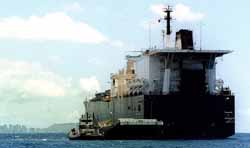
Photo by Lance Cpl. Dustin Senger
(high resolution photos attached at end of article.)

Marine Corps News
FLOATING LOGISTICS BASE ARRIVES OFF HAWAII >
Posted 10/09/98 08:51:21 PM --- More MARFORPAC news articles
 |
| The MV Williams stopped of Oahu recently and gave Hawaii Marines a chance to check out the Corps' MPF concept up close Photo by Lance Cpl. Dustin Senger (high resolution photos attached at end of article.) |